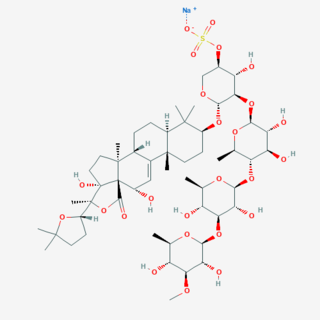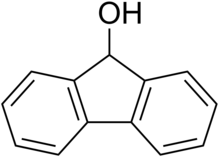
The pyrethrins are a class of organic compounds normally derived from Chrysanthemum cinerariifolium that have potent insecticidal activity by targeting the nervous systems of insects. Pyrethrin naturally occurs in chrysanthemum flowers and is often considered an organic insecticide when it is not combined with piperonyl butoxide or other synthetic adjuvants. Their insecticidal and insect-repellent properties have been known and used for thousands of years.

Armodafinil (trade name Nuvigil) is the enantiopure compound of the eugeroic modafinil (Provigil). It consists of only the (R)-(−)-enantiomer of the racemic modafinil. Armodafinil is produced by the pharmaceutical company Cephalon Inc. and was approved by the U.S. Food and Drug Administration (FDA) in June 2007. In 2016, the FDA granted Mylan rights for the first generic version of Cephalon's Nuvigil to be marketed in the U.S.

The holothurins are a group of toxins originally isolated from the sea cucumber Actinopyga agassizii. They are contained within clusters of sticky threads called Cuvierian tubules which are expelled from the sea cucumber as a mode of self-defence. The holothurins belong to the class of compounds known as saponins and are anionic surfactants which can cause red blood cells to rupture. The holothurins can be toxic to humans if ingested in high amounts.

Acetarsol is an anti-infective drug.

Eugeroics, also known as wakefulness-promoting agents and wakefulness-promoting drugs, are a class of drugs that promote wakefulness and alertness. They are medically indicated for the treatment of certain sleep disorders including excessive daytime sleepiness (EDS) in narcolepsy or obstructive sleep apnea (OSA). Eugeroics are also often prescribed off-label for the treatment of EDS in idiopathic hypersomnia. In contrast to classical psychostimulants, such as methylphenidate and amphetamine, which are also used in the treatment of these disorders, eugeroics typically do not produce marked euphoria, and, consequently, have a lower addictive potential.

Demeton, sold as an amber oily liquid with a sulphur like odour under the name Systox, is an organophosphate derivative causing irritability and shortness of breath to individuals repeatedly exposed. It was used as a phosphorothioate insecticide and acaricide and has the chemical formula C8H19O3PS2. Although it was previously used as an insecticide, it is now largely obsolete due to its relatively high toxicity to humans. Demeton consists of two components, demeton-S and demeton-O in a ratio of approximately 2:1 respectively. The chemical structure of demeton is closely related to military nerve agents such as VX and a derivative with one of the ethoxy groups replaced by methyl was investigated by both the US and Soviet chemical-weapons programs under the names V.sub.X and GD-7.

Xanthydrol is an organic chemical compound. Its formula is C13H10O2. Its total molecular weight is 198.221 g/mol. Xanthydrol is used to test the levels of urea in the bloodstream.

Censavudine (INN) (BMS-986001) is an investigational new drug being developed by Bristol Myers-Squibb for the treatment of HIV infection. It was originally developed at Yale University. It is still in an investigational phase of development as of 2023.
Neoendorphins are a group of endogenous opioid peptides derived from the proteolytic cleavage of prodynorphin. They include α-neoendorphin and β-neoendorphin. The α-neoendorphin is present in greater amounts in the brain than β-neoendorphin. Both are products of the dynorphin gene, which also expresses dynorphin A, dynorphin A-(1-8), and dynorphin B. These opioid neurotransmitters are especially active in Central Nervous System receptors, whose primary function is pain sensation. These peptides all have the consensus amino acid sequence of Try-Gly-Gly-Phe-Met (met-enkephalin) or Tyr-Gly-Gly-Phe-Leu ( leu-enkephalin). Binding of neoendorphins to opioid receptors (OPR), in the dorsal root ganglion (DRG) neurons results in the reduction of time of calcium-dependent action potential. The α-neoendorphins bind OPRD1(delta), OPRK1(kappa), and OPRM1 (mu) and β-neoendorphin bind OPRK1.

Methoxyethylmercuric acetate is a chemical compound formerly used as a pesticide for seeds of cotton and small grains. It is highly toxic, and can pose a threat to the brain and central nervous system.

Triazofos is a chemical compound used in acaricides, insecticides, and nematicides.

Curzerene is a volatile, aromatic terpenoid found in many herbs and spices, such as Curcuma zeodaria. It is bioactive isolate of Caribbean corals and is also found in myrrh. More specifically it has been found to make up a significant portion - 12.97% - of the smoke produced from burning Commiphora myrrha oleo gum resin. It is also a major component of myrrh oil, which has been shown in vitro to possess anti-inflammatory properties at sub-toxic by inhibiting the production of the inflammatory cytokine IL-6 by human gingival fibroblasts. Anecdotal evidence exists to support the anti-inflammatory effect of myrrh oil.

Dioscorine is an alkaloid toxin isolated from the tubers of tropical yam on several continents. It has been used as a monkey poison in some African countries, and as an arrow poison to aid in hunting in several parts of Asia. It was first isolated from Dioscorea hirsute by Boorsma in 1894 and obtained in a crystalline form by Schutte in 1897, and has since been found in other Dioscorea species. Dioscorine is a neurotoxin that acts by blocking the nicotinic acetylcholine receptor. Dioscorine is generally isolated in tandem with other alkaloids such as dioscin but is usually the most potent toxin in the mixture. It is a convulsant, producing symptoms similar to picrotoxin, with which it shares a similar mechanism of action.

Crufomate is an insecticide.

Buprofezin is an insecticide used for control of insect pests such as mealybugs, leafhoppers and whitefly on vegetable crops. It is a growth regulator, acting as an inhibitor of chitin synthesis. It is banned in some countries due to its negative environmental impacts, being especially toxic to aquatic organisms as well as non-target insects, though is of low toxicity to humans and other mammals.

Pregnenolone acetate, also known as pregn-5-en-3β-ol-20-one 3β-acetate, is a synthetic pregnane steroid and an ester of pregnenolone which is described as a glucocorticoid and as a skin-conditioning and skin anti-aging agent. It has been reported to reduce wrinkles in elderly women when applied in the form of a 0.5% topical cream, effects which were suggested to be due to improved hydration of the skin. Pregnenolone acetate has been marketed in France in a topical cream containing 1% pregnenolone acetate and 10% "sex hormone" for the treatment of premature skin aging but was withdrawn from the market in 1992. Although the medication has been described by some sources as a glucocorticoid, other authors have stated that systemic pregnenolone acetate has no undesirable metabolic or toxic effects even at high doses.
Methionol is a methyl sulfide derived from propan-1-ol. It is found in nature, including as a metabolite of yeast and bacillus anthracis. It is a sulphurous aroma component of many foods, such as wine, cheese and roasted coffee. It is classed as an irritant. It has a very low olfactory threshold.

EA-1763, O-PPVX, V1 or propyl S-2-diisopropylaminoethylmethylphosphonothiolate, is a military-grade neurotoxic organophosphonate nerve agent related to VX. It is part of the V-series. The substitution of a proton for methyl makes its properties more similar to those of VX.

Diglycidyl aniline is an aromatic organic chemical in the glycidyl compound family. It is used to reduce the viscosity of epoxy resin systems. It has the empirical formula C12H15NO2 and the IUPAC name is N,N-bis(oxiran-2-ylmethyl)aniline. The CAS number is 2095-06-9. It is REACH registered in Europe with the EC number 218-259-5. A key use is in the viscosity reduction of epoxy resin systems functioning as a reactive diluent.



















